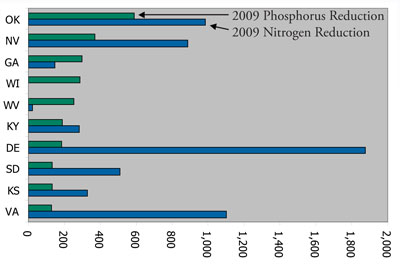EPA Ranks Oklahoma in Top Five for Improving Water Quality
Recent EPA numbers rank Oklahoma among the best states in controlling nonpoint source pollution.
Oklahoma conservation programs improving water quality. State legislators made the announcement at a news conference held at the Oklahoma state Capitol on March 17.

The top ten states for phosphorus reduction (green) including associated nitrogen reduction (blue) in thousands of pounds.
The dedicated work of farmers, ranchers and other landowners to control non-point source pollution in Oklahoma by using voluntary programs administered by the Oklahoma Conservation Commission and local conservation districts is paying off according to new water quality numbers recently released by the U.S. Environmental Protection Agency (EPA). Recent analysis of nutrient and sediment reduction numbers from across the nation shows that Oklahoma now ranks among the top five states in reducing contamination in our streams and rivers, an accomplishment Senator Ron Justice (R-Chickasha), Chair of the Oklahoma State Senate Rural Caucus, said all citizens of the state should be proud of.
“All Oklahoman’s should take pride in this accomplishment,” Justice said. “When given the chance and when given technical and financial help from the state and federal governments, Oklahoma’s agriculture producers and other landowners have been willing to step forward and do what needs to be done to protect our water.”
State Reps. Skye McNeil (R-Bristow) and Cory Holland (R-Marlow), co-chairs of the Oklahoma House of Representatives Rural Caucus agreed, noting that this new ranking from the EPA shows that the voluntary approach used by the state and utilizing the partnership of the Conservation Commission, local conservation districts and the USDA Natural Resources Conservation Service (NRCS) is working and should serve as a model for other states.
“These new water quality numbers show that the focus we have put on working with landowners through voluntary programs works when the program is structured right,” McNeil said. “By utilizing the delivery system consisting of the Oklahoma Conservation Commission, local conservation districts and NRCS, we have been able to use Federal Clean Water Act dollars to partner with landowners in a way that not only controls pollution, but also respects private property rights and takes into consideration the financial situation of the local landowner.”
“This approach shows that protecting the environment and profitable production agriculture can go hand-in-hand,” Holland said. “This is quite an accomplishment and I am hopeful the federal government and other states will take notice.”
Water quality numbers released at the beginning of March show that over 10 percent of the total amount of nitrogen reduced from water nation-wide was accounted for by reductions in Oklahoma. Of total national reductions of phosphorous in water, over 16 percent of all reductions happened in Oklahoma and a significant reduction of soil particle delivery to the state’s waters was shown as well. When reviewing these numbers in comparison with the levels of non-point source pollution reduced by other states, Oklahoma was shown to be one of the top five states in the nation in total nutrient and sediment reduction in the surface water of the state while receiving less than one percent of all federal EPA non-point source pollution funds.
“The mission of the Oklahoma Conservation Commission is to conserve, protect, and restore Oklahoma’s natural resources, working in collaboration with the conservation districts and other partners, on behalf of the citizens of Oklahoma,” said Shanon Phillips, OCC’s Water Quality Division director. “OCC receives a combination of state and federal dollars to carry out this mission. As a condition of receiving these monies, it is important that we showcase our programs’ effectiveness,” Phillips said. “For this reason, EPA annually requires the state to estimate reduction of the most significant causes of nonpoint source pollution — nitrogen, phosphorus, and sediment — that can be linked to the Clean Water Act Section 319 Nonpoint Source Pollution Program. Although Oklahoma always performs well, the numbers for 2009 were exceptional. Many water quality challenges remain, but through the voluntary efforts of Oklahomans statewide, we’re making great progress,” Phillips said.
According to Clay Pope, executive director of the Oklahoma Association of Conservation Districts, this water quality success was achieved through voluntary cost-share efforts similar to those used by conservationists to address soil erosion since the dust bowl of the 1930s. Through funding from the EPA’s Clean Water Act Section 319 program, the Farm Services Agency’s (FSA) Conservation Reserve Enhanced Program (CREP), Farm Bill conservation programs administered by the NRCS, state conservation programs administered by the Conservation Commission and with local leadership from conservation districts, Pope said farmers, ranchers and other landowners are working to protect our natural resources.
“In the past, the government learned that it was best to work cooperatively with landowners to address environmental concerns.” Pope said. “By helping individuals with technical and financial assistance, farmers, ranchers and other landowners are willing to put their own money out of their own pocket into cost-share projects designed to address concerns like water quality. This approach worked to tame the dust bowl and this recent recognition by the EPA shows it can also work to address non-point source pollution. By working cooperatively with landowners we can get a handle on these issues. This high ranking in the area of water quality success proves it!”
